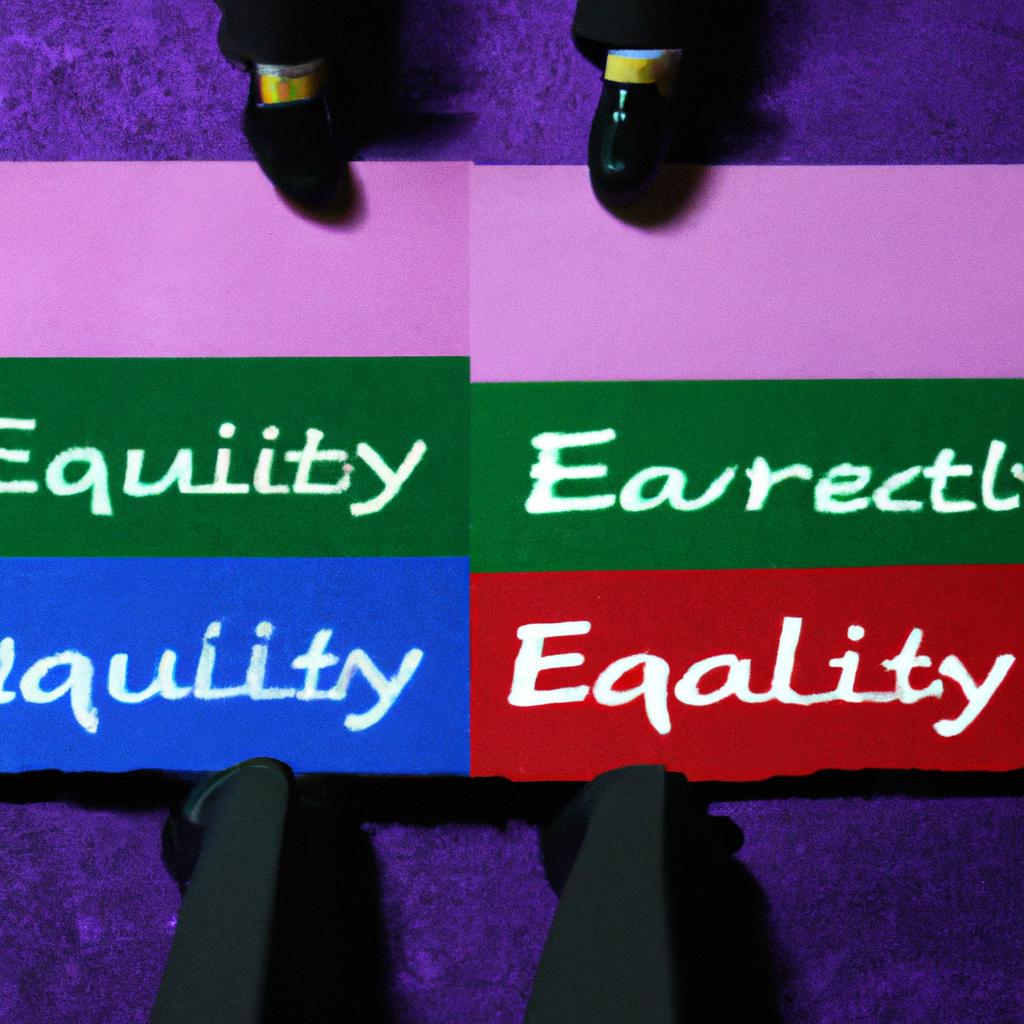Voting rights have long been a crucial aspect of civil rights in both society and organizations. The ability to vote serves as a cornerstone of democratic societies, ensuring that individuals have their voices heard and can actively participate in the decision-making processes that shape their lives. However, throughout history, there have been numerous challenges faced by marginalized groups seeking equal access to the ballot box. For instance, consider the case study of the Civil Rights Movement in the United States during the 1960s. African Americans fought tirelessly against discriminatory practices such as poll taxes, literacy tests, and voter intimidation tactics, striving for equal voting rights.
In addition to societal contexts, organizations also play a significant role in shaping voting rights within their structures. Organizations are microcosms of society with diverse members who possess unique perspectives and experiences. Consequently, it becomes imperative for these entities to ensure equitable representation through inclusive decision-making processes that uphold every individual’s right to vote. Failure to do so not only undermines democracy but also perpetuates systemic inequalities within organizational structures. Therefore, this article aims to shed light on the importance of voting rights concerning civil rights while exploring various challenges encountered at both societal and organizational levels. By examining historical events and contemporary examples alike, we can gain insights into how far we have come in the fight for voting rights and identify areas that still require attention and improvement.
One significant milestone in the advancement of voting rights was the passage of the Voting Rights Act of 1965 in the United States. This legislation aimed to eliminate discriminatory practices that prevented African Americans from exercising their right to vote, such as literacy tests and poll taxes. The act also authorized federal oversight of election procedures in states with a history of voter suppression.
Since then, progress has been made in expanding access to voting rights. Efforts such as early voting, mail-in ballots, and online registration have made it easier for individuals to participate in elections. However, challenges persist, particularly concerning voter ID laws, gerrymandering, and restrictive registration requirements that disproportionately affect marginalized communities.
Organizations must also recognize their role in promoting inclusive decision-making processes that respect voting rights. This involves fostering an environment where all members feel empowered to express their opinions and contribute to important decisions. Organizations can establish policies that encourage voter participation by providing time off for employees to vote or hosting informational sessions about candidates and issues.
Furthermore, organizations should actively work towards diversifying their leadership structures through inclusive nomination processes and equitable representation on governing boards. By ensuring diverse voices are heard at every level of decision-making, organizations can better reflect the needs and perspectives of all members.
In conclusion, voting rights are essential for both societal democracy and organizational equity. While progress has been made over time, challenges remain in achieving equal access to the ballot box. By acknowledging historical struggles like those faced during the Civil Rights Movement while addressing contemporary obstacles, we can continue working towards a more inclusive society where every individual’s voice is valued and represented.
Historical context of voting rights
In the historical context, voting rights have played a significant role in shaping civil rights movements and advocating for social justice. One compelling example that highlights the importance of voting rights is the case study of African Americans during the Jim Crow era in the United States. During this time, discriminatory laws and practices were implemented to suppress the political power of African Americans, denying them their fundamental right to vote.
To understand the broader impact of voting rights on society and organizations, it is crucial to recognize some key points:
- Exclusionary Practices: Throughout history, various exclusionary practices were employed by those in power to limit access to voting. These included literacy tests, poll taxes, and grandfather clauses designed specifically to disenfranchise marginalized communities.
- Systemic Discrimination: The denial of voting rights perpetuated systemic discrimination against minority groups. This further entrenched existing inequalities in areas such as education, employment opportunities, and representation within legislative bodies.
- Civil Rights Movements: The fight for voting rights became intertwined with larger civil rights movements across different countries and eras. Activists like Martin Luther King Jr., Rosa Parks, and suffragettes fought tirelessly for equal access to democracy through nonviolent protests and legal challenges.
- Progressive Reforms: Over time, progress has been made toward expanding voter enfranchisement. Landmark legislation such as the U.S. Voting Rights Act of 1965 sought to dismantle discriminatory barriers that hindered equal participation in elections.
Drawing attention to these aspects can evoke an emotional response from readers who may empathize with individuals or communities affected by historic injustices related to voting rights.
| Impacts of Voter Suppression | Consequences of Limited Representation | Importance of Inclusive Democracy |
|---|---|---|
| Disenfranchisement | Lack of Policy Influence | Strengthening Society |
| Weakening of Democracy | Underrepresentation | Ensuring Equality |
| Marginalization | Diminished Trust in Institutions | Fostering Social Justice |
Understanding the historical context and its implications sets the stage for examining the impact of voting rights on marginalized communities. By recognizing past injustices, we can better appreciate the urgency to address present-day challenges and strive for a more inclusive society that values equal participation for all citizens.
Impact of voting rights on marginalized communities
Transitioning from the historical context of voting rights, it is evident that the impact of these rights extends far beyond their initial enactment. To illustrate this point, let us consider a hypothetical scenario where an individual from a marginalized community faces barriers while attempting to exercise their right to vote. This example serves as a reminder that even in modern society, challenges persist.
The struggle for voting rights has profound implications for marginalized communities who often find themselves at the receiving end of systemic discrimination. It is crucial to understand how these communities are affected by examining key aspects related to voting rights:
-
Voter Suppression Tactics: Various methods have been employed throughout history and continue today to suppress voter turnout among specific groups. Examples include strict ID requirements, purging voter rolls without proper notification, reducing early voting opportunities, and gerrymandering electoral districts.
-
Disproportionate Impact: Marginalized communities disproportionately bear the brunt of voter suppression tactics due to factors such as socioeconomic disparities, limited access to transportation or identification documents, language barriers, and historic disenfranchisement.
-
Political Representation: When members of marginalized communities face obstacles in exercising their right to vote, it hinders their ability to elect representatives who truly reflect their interests and concerns. This lack of representation perpetuates marginalization and exacerbates existing inequalities within society.
-
Amplifying Inequality: Denying individuals from marginalized communities equal access to the ballot box reinforces societal inequities by limiting their participation in decision-making processes that determine policies affecting them directly.
To further underscore the significance of these issues surrounding voting rights, consider the following table:
| Issue | Implications |
|---|---|
| Voter Suppression | Reduces democratic participation and undermines fair elections |
| Disproportionate Impact | Reinforces systemic injustices and widens social inequality |
| Political Representation | Weakens the power of marginalized communities to shape policies that affect their lives |
| Amplifying Inequality | Perpetuates existing disparities and hampers efforts toward a more equitable society |
In light of these ongoing challenges, it is imperative to address them comprehensively. The subsequent section will delve into the various obstacles faced by individuals seeking to exercise their voting rights, shedding light on the complexities surrounding this fundamental democratic process.
Transitioning smoothly into the next section on “Challenges to voting rights,” we explore how systemic barriers continue to impede access to fair elections and hinder progress towards a more inclusive democracy.
Challenges to voting rights
Building upon the impact of voting rights on marginalized communities, it is crucial to acknowledge the challenges that exist within the realm of ensuring equal access to this fundamental democratic process. These challenges pose significant barriers for individuals and groups seeking to exercise their right to vote. By examining specific instances, we can better understand the complexities surrounding voting rights in society.
Case Study: Take, for example, a hypothetical scenario where a community predominantly composed of racial minorities experiences disproportionately long wait times at polling stations compared to more affluent neighborhoods. This discrepancy creates an environment where certain individuals are discouraged or even unable to cast their votes due to time constraints or other commitments. Such disparities not only undermine the principle of equality but also perpetuate systemic inequalities by limiting political representation of minority voices.
The following bullet point list highlights key challenges faced by marginalized communities when it comes to exercising their voting rights:
- Voter suppression tactics targeting specific demographics (e.g., strict voter ID laws)
- Gerrymandering practices that dilute the influence of marginalized communities
- Limited accessibility at polling locations for individuals with disabilities
- Disinformation campaigns aimed at spreading falsehoods about elections
To further illustrate these challenges, consider the table below which outlines some real-world examples:
| Challenge | Impact | Example |
|---|---|---|
| Voter Suppression | Disenfranchisement | Strict voter ID laws in several states |
| Gerrymandering | Underrepresentation | Manipulation of district boundaries |
| Accessibility | Exclusion | Lack of ramps and accommodations at polling places |
| Disinformation | Misinformed electorate | Spreading false information through social media |
It is evident that confronting these obstacles requires substantial effort from both civil society organizations and governmental bodies. Recognizing and addressing such challenges is essential in safeguarding democracy and promoting inclusivity within electoral processes.
Transition into subsequent section: Understanding the challenges faced by marginalized communities in exercising their voting rights underscores the critical role of legislation in protecting and upholding these rights. By examining various legislative measures, we can gain insight into how statutory frameworks aim to preserve equal access to the ballot box for all citizens.
Role of legislation in protecting voting rights
Challenges to Voting Rights
The fight for voting rights has been met with numerous challenges throughout history, as various barriers have hindered equal access to the ballot box. One example of such a challenge is voter suppression tactics that disproportionately affect marginalized communities. For instance, in recent years, restrictive voter ID laws have emerged in several states, requiring voters to present specific forms of identification that may be more difficult for certain groups to obtain. This creates an unequal playing field and hampers the ability of individuals from these communities to exercise their right to vote freely.
- Intimidation at polling stations: Instances where voters from minority backgrounds are subjected to intimidation or harassment while attempting to cast their ballots.
- Gerrymandering: The deliberate manipulation of electoral district boundaries to benefit one political party over another, often resulting in disproportionate representation.
- Felony disenfranchisement: Laws that restrict voting rights for individuals convicted of felonies even after they have served their sentences.
- Language barriers: Limited availability of bilingual assistance or translated materials can create obstacles for non-native English speakers seeking information about elections.
In addition to these challenges, it is important to recognize the role legislation plays in protecting voting rights. Legislation aimed at safeguarding this fundamental democratic process helps ensure fair and equal participation for all eligible citizens. To highlight this point, let’s examine a three-column table showcasing examples of legislative measures implemented across different jurisdictions:
| Jurisdiction | Legislative Measure | Purpose |
|---|---|---|
| United States | National Voter Registration Act (NVRA) | Streamlines voter registration procedures |
| Australia | Compulsory Voting | Encourages broader citizen engagement |
| South Africa | Promotion of Access Democracy Act | Expands accessibility through special votes |
These legislative efforts demonstrate how governments can actively work towards protecting voting rights and promoting inclusivity within their respective societies. By implementing measures such as the NVRA in the United States, enabling compulsory voting in Australia, or enacting acts like South Africa’s Promotion of Access Democracy Act, these jurisdictions demonstrate a commitment to ensuring that all eligible citizens have equal opportunities to participate in the democratic process.
As we delve deeper into understanding the challenges faced by voting rights advocates and the role of legislation in addressing them, it becomes evident that there is an ongoing need for concerted efforts to protect and expand voting rights. In our subsequent section on “Efforts to Expand Voting Rights,” we will explore initiatives aimed at widening access to the ballot box and overcoming systemic barriers that limit civic participation.
Efforts to expand voting rights
Transitioning from the role of legislation in protecting voting rights, it is important to shed light on the ongoing efforts aimed at expanding these crucial rights. To illustrate this point further, let us consider a hypothetical case study involving a marginalized community that historically faced barriers to exercising their right to vote.
Imagine an underrepresented group residing in a predominantly rural area with limited access to polling stations. Despite legal protections, they encounter challenges such as long distances between their homes and the nearest polling location, lack of transportation options, and inadequate resources to obtain required identification documents. These obstacles disproportionately affect this community’s ability to participate fully in the democratic process.
To address such issues and ensure equal voting opportunities for all citizens, various organizations and activists have been working tirelessly towards expanding voting rights across society. Their endeavors are driven by a shared goal of fostering inclusivity and enabling every eligible individual to exercise their civic duty without hindrance. Here are some key initiatives undertaken:
-
Community Outreach Programs:
- Establishing mobile registration centers.
- Conducting public awareness campaigns about voter eligibility requirements.
- Providing necessary information regarding accessible transportation services or alternatives.
-
Advocacy for Legislative Reforms:
- Lobbying policymakers for increased funding towards improving infrastructure surrounding polling locations.
- Pushing for legislative measures that streamline the process of obtaining identification documents.
- Promoting policies that facilitate early voting or absentee ballots for individuals facing circumstances that prevent them from physically reaching polls on Election Day.
-
Grassroots Mobilization:
- Encouraging volunteerism through local networks dedicated to helping voters navigate potential barriers.
- Organizing informational sessions highlighting the importance of active participation in elections.
- Collaborating with other civil rights organizations to amplify voices advocating for expanded voting rights.
These efforts exemplify the collective spirit of those striving to uphold democratic principles and ensure that voting remains accessible to all members of society. By fostering engagement, addressing challenges, and promoting inclusivity, these initiatives aim to strengthen the foundations of our democracy.
Transitioning into the subsequent section on “The future of voting rights,” it is evident that the ongoing endeavors discussed above provide a solid groundwork for further progress in safeguarding and expanding access to this fundamental aspect of citizenship.
The future of voting rights
Efforts to Expand Voting Rights: A Historical Perspective
The fight for expanding voting rights has been a longstanding battle in societies and organizations around the world. Examining the historical context of this struggle provides insights into both the progress made and challenges that persist. One example that highlights the significance of this issue is the case study of women’s suffrage movement in the United States.
In the early 20th century, women fought vigorously for their right to vote, facing immense opposition and discrimination. The suffragettes organized protests, engaged in civil disobedience, and tirelessly advocated for equal voting rights through various channels. Their efforts culminated in the passage of the Nineteenth Amendment to the U.S. Constitution in 1920, which granted American women full suffrage. This milestone achievement symbolized a major victory for gender equality and paved the way for subsequent movements fighting against voter suppression.
Despite significant progress over time, it is crucial to acknowledge that challenges related to voting rights still exist today. To shed light on these ongoing issues, let us explore some key concerns:
- Voter ID laws disproportionately affect marginalized communities by creating barriers to accessing polls.
- Gerrymandering can manipulate electoral districts in favor of certain political parties or groups, undermining fair representation.
- Felony disenfranchisement policies restrict individuals with criminal records from exercising their right to vote even after completing their sentences.
- Disinformation campaigns aimed at spreading false information about elections can influence voters’ choices and undermine trust in democratic processes.
To better understand these concerns, consider the following table highlighting statistical data related to voting rights:
| Concern | Statistics |
|---|---|
| Voter ID Laws | Over 21 million Americans lack government-issued photo identification (Brennan Center for Justice) |
| Gerrymandering | In 2018 midterm elections, Democrats received approximately 59% of all votes cast nationwide but won only 235 out of 435 seats in the House of Representatives (Politico) |
| Felony Disenfranchisement | An estimated 5.2 million Americans are barred from voting due to felony convictions, disproportionately impacting people of color (The Sentencing Project) |
| Disinformation Campaigns | In the 2016 U.S. presidential election, Russian troll farms reached over 100 million Americans through social media platforms (Senate Intelligence Committee Report) |
As we reflect on these concerns and statistics, it becomes evident that there is still work to be done to ensure equitable access to voting rights for all citizens. Efforts must continue towards dismantling barriers, promoting fair representation, and protecting democratic processes.
By examining both historical milestones and ongoing challenges, society and organizations can strive towards a future where every individual’s voice is heard at the ballot box. The next section will explore potential strategies and initiatives that could shape this future landscape of voting rights.
 The Window
The Window



